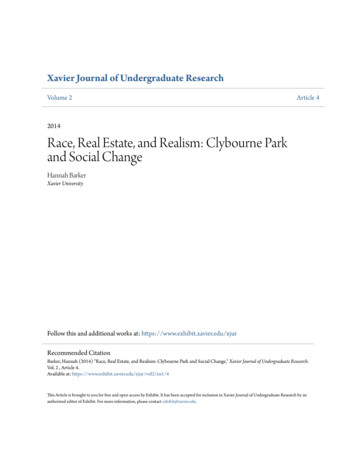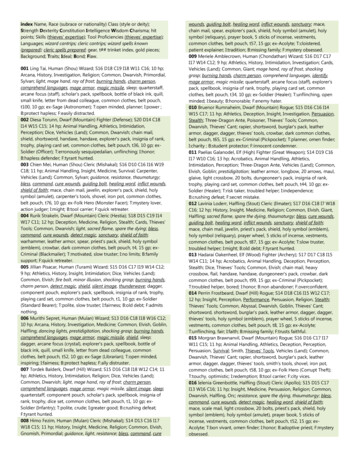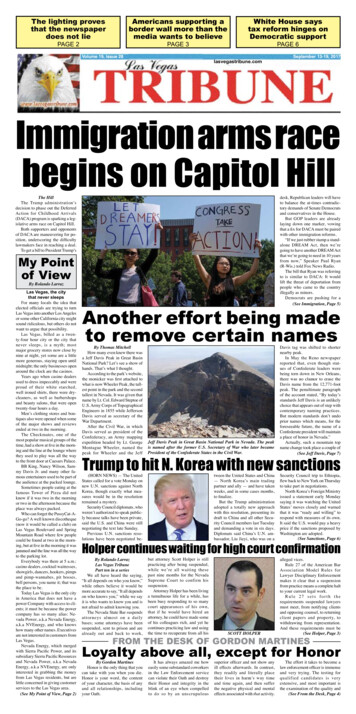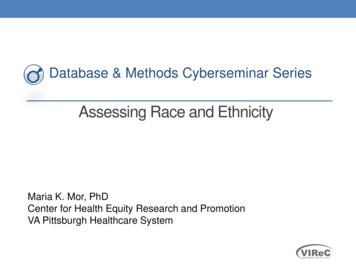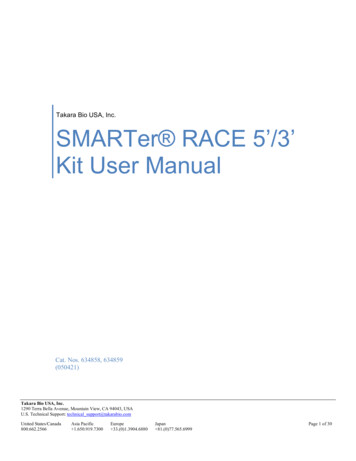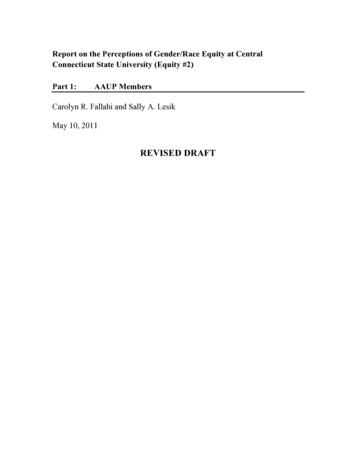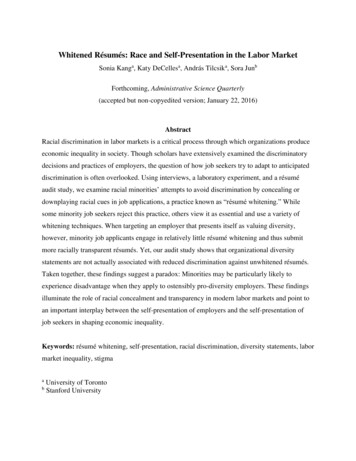
Transcription
Whitened Résumés: Race and Self-Presentation in the Labor MarketSonia Kanga, Katy DeCellesa, András Tilcsika, Sora JunbForthcoming, Administrative Science Quarterly(accepted but non-copyedited version; January 22, 2016)AbstractRacial discrimination in labor markets is a critical process through which organizations produceeconomic inequality in society. Though scholars have extensively examined the discriminatorydecisions and practices of employers, the question of how job seekers try to adapt to anticipateddiscrimination is often overlooked. Using interviews, a laboratory experiment, and a résuméaudit study, we examine racial minorities’ attempts to avoid discrimination by concealing ordownplaying racial cues in job applications, a practice known as “résumé whitening.” Whilesome minority job seekers reject this practice, others view it as essential and use a variety ofwhitening techniques. When targeting an employer that presents itself as valuing diversity,however, minority job applicants engage in relatively little résumé whitening and thus submitmore racially transparent résumés. Yet, our audit study shows that organizational diversitystatements are not actually associated with reduced discrimination against unwhitened résumés.Taken together, these findings suggest a paradox: Minorities may be particularly likely toexperience disadvantage when they apply to ostensibly pro-diversity employers. These findingsilluminate the role of racial concealment and transparency in modern labor markets and point toan important interplay between the self-presentation of employers and the self-presentation ofjob seekers in shaping economic inequality.Keywords: résumé whitening, self-presentation, racial discrimination, diversity statements, labormarket inequality, stigmaabUniversity of TorontoStanford University
Employment discrimination is a critical process through which organizations can shapethe extent and nature of economic inequality in society (Bielby and Baron, 1986; Rivera, 2012a;Pager, Western, and Bonikowski, 2009). Despite the proliferation of equal opportunity anddiversity initiatives in organizations (Kalev, Dobbin, and Kelly, 2006; Kaiser et al., 2013),discrimination on the basis of race, in particular, remains pervasive in North American labormarkets. Résumé audit studies—field experiments that send matched résumé pairs in response toreal job postings—consistently show evidence of race-based discrimination. Résumés containingminority racial cues, such as a distinctively African American or Asian name, lead to 30% to50% fewer callbacks from employers than do otherwise equivalent résumés without such cues(Bertrand and Mullainathan, 2004; Oreopoulos, 2011; Gaddis, 2015). Given the crucial role ofhiring in occupational attainment, this form of discrimination substantially contributes to labormarket inequalities by blocking racial minorities’ access to career opportunities (Pager, 2007).While the audit literature demonstrates persistent employment discrimination againstracial minorities, it provides little insight into how job seekers adapt to this discrimination. Byfocusing on the demand side of the labor market, this literature does “not reveal the extent towhich [minority] individuals change their behavior to avoid experiencing discrimination”(Blank, Dabady and Citro, 2004: 112; see Pager and Pedulla, 2015). Thus the nature andconsequences of the actions that racial minority job seekers might take in anticipation ofdiscrimination remain incompletely understood.Previous studies have highlighted minority job seekers’ use of informal job referralnetworks (Smith, 2005) and their attempts to cast a relatively wide net in their job search to reachat least some fraction of non-discriminatory employers (Pager and Pedulla, 2015). However, theliterature has largely overlooked a distinct and potentially critical action that minorities might2
take to try to avoid anticipated discrimination: changing how they present themselves—especially in relation to racial cues—when applying for jobs. Five decades ago, Goffman (1963)observed how racial minorities attempt to conceal or downplay their minority status in the labormarket and beyond. Popular accounts suggest that, even today, minority job seekers might try toavoid discrimination by omitting or strategically presenting race-related information in their jobapplication materials (Luo, 2009a; Tahmincioglu, 2009; Yoshino, 2006). A 2009 article in TheNew York Times, for example, pointed to a phenomenon colloquially known as “whitening therésumé,” whereby black job seekers concealed or “dialed back” racial cues on their résumés(Luo, 2009b). For instance, the article discusses Yvonne Orr, a black woman searching for workin Chicago, who deliberately removed a position at an African American nonprofit organizationfrom her résumé to increase her chances of getting job interviews. While such actions have beenobserved anecdotally, systematic research on the nature and consequences of this phenomenon incontemporary labor markets is practically nonexistent.We investigate résumé whitening by combining qualitative and experimental approaches.First, we qualitatively explore how and why individuals engage in résumé whitening byconducting in-depth interviews with racial minority university students who are about to enterthe job market. The interviews shed light on why minority job seekers engage in résuméwhitening at the earliest stages of the job application process before their minority status wouldbecome obvious to employers (e.g., at an in-person interview). Second, we build on ourqualitative findings by conducting a laboratory experiment to examine how job seekers changetheir résumés in response to different job postings. Third, we report results from a résumé auditstudy that explores how employers respond to whitened and unwhitened résumés. These threeapproaches are complementary. The interviews provide fine-grained qualitative insights into the3
nature of résumé whitening. The lab experiment, conducted with a distinct sample, allows us toobserve variation in résumé whitening in a controlled setting. Finally, our audit study providesinsight into the labor market consequences of résumé whitening.We find that while some minority applicants do not engage in résumé whitening andmight even take steps to highlight their race, others routinely use a variety of whiteningtechniques. Our lab experiment explores situational and individual variation in this practice. Thekey result from this experiment is that job seekers are less likely to whiten their résumés whentargeting an organization that presents itself as being committed to workplace diversity. Ourrésumé audit, however, suggests that pro-diversity statements are not actually associated withmore favorable treatment of unwhitened résumés. Diversity statements, therefore, might giveminority job seekers a false sense of security, signaling equal opportunity where discriminationstill exists, and encouraging them to reveal racial cues that they might otherwise downplay orconceal. This suggests a paradox: Because minority job seekers tend to respond to diversitystatements with greater racial transparency, they may be especially likely to experiencedisadvantage when applying to employers that emphasize their commitment to diversity.RACE, STIGMA, AND SELF-PRESENTATIONIn Stigma: Notes on the Management of Spoiled Identity (1963), Goffman notes thatracial minority status can be a form of “tribal stigma,” a collective stigma based on real orimagined attributes associated with a racial group. This, in turn, leads to “discrimination, throughwhich we effectively, if often unthinkingly, reduce [a person’s] life chances” (Goffman, 1963:5). Goffman, however, emphasizes that stigmatized individuals might attempt to mitigate thenegative impact of stigma by managing the information they convey about themselves. This4
basic insight provides a basis for conceptualizing how, through self-presentation, people mightattempt to “dodge stigmatizing processes” (Link and Phelan, 2001: 378).According to Goffman, one form of self-presentation by stigmatized individuals involvesattempts at concealing the stigma to “pass” as a member of the dominant, non-stigmatized group.Historians have observed numerous instances of racial passing—from the antebellum era to the20th century—but they have focused on light-skinned African Americans and multiracialindividuals who could pass as white in virtually all interpersonal interactions (Hobbs, 2014).Although this kind of passing is not an option for most racial minorities, Goffman (1963: 74)notes that there are situations in which temporary passing can be an option even for individualswhose racial minority status would be immediately revealed in an in-person interaction: there are many cases when it appears that an individual’s stigma will always be apparent,but where this proves to be not quite the case; for on examination one finds that theindividual will occasionally be in a position to elect to conceal crucial information abouthimself . black skinned [individuals] who have never passed publicly may nonetheless findthemselves, in writing letters or making telephone calls, projecting an image of self that is[only] subject to later discrediting. (emphasis added)This type of selective, temporary passing may be particularly relevant for the job applicationprocess in modern labor markets, as these often involve an initial résumé-screening phase (andsometimes a phone interview), with in-person interviews conducted only at a later stage.Another way of managing a stigmatized identity is what Goffman (1963) calls“covering.” When covering, individuals attempt neither to completely conceal a stigmatizedcharacteristic (such as their racial minority status), nor to appear as a member of the nonstigmatized majority group. Rather, the goal is to downplay the salience of characteristics thatfoster stigmatization. Thus, “persons who are ready to admit possession of a stigma (in manycases because it is known about or immediately apparent) may nonetheless make a great effort tokeep the stigma from looming large” (Goffman, 1963: 103). Thus, covering does not render a5
disfavored identity invisible, but makes its most damaging aspects less prominent, and thusperhaps signals conformity to the non-stigmatized mainstream (Yoshino, 2006). Covering ofteninvolves restricting information about the aspects of one’s identity that would be most likely tobecome a basis for discrimination, and this may be an important “assimilative technique” forracial and ethnic minorities (Goffman 1963: 103):[One] type of covering involves an effort to restrict the display of those failings mostcentrally associated with the stigma This type of covering, it should be noted, is animportant aspect of the “assimilative” techniques employed by members of minority ethnicgroups; the intent behind devices such as change in name is not solely to pass, but also torestrict the way in which a known-about attribute obtrudes itself into the center of attention Thus, in the context of race, covering involves “toning down,” rather than hiding, one’s minoritystatus, perhaps in order to send reassuring signals of conformity to the white majority.Though Goffman’s classic insights into passing and covering are instructive, little isknown about how these behaviors operate in modern labor markets, the conditions andmotivations under which they occur, and their consequences for employment outcomes. Weexplore each of these issues in turn, using interviews, a lab experiment, and a field experiment.STUDY 1: INTERVIEWSIn the first phase of our investigation, we explored résumé whitening through interviews,focusing on black and Asian university students who were actively searching for jobs orinternships.1 This approach offered several advantages. First, the interviews provided anopportunity for an in-depth exploration of the subjective interpretations that shape résuméwhitening, allowing us to identify the issues that were most salient to active job seekers. Second,the focus on job-seeking university students illuminated résumé whitening at the first, criticalFollowing our participants’ lead, we use the label “black” rather than “African American,” and the label “Asian”rather than “Asian American.” Although our respondents occasionally used the terms “African American” and“Asian American,” they typically did so to describe organizations rather than themselves or other people (e.g.,“African American Students’ Association” versus “the employer would know that I am black”). In accordance withstandard ASQ style, we do not capitalize the words “black” and “white” but capitalize “Asian” and “Hispanic.”16
point of entry into relatively highly paid job tracks—an important mechanism in economicstratification (Rivera, 2012a). Third, the focus on black and Asian job seekers was informativebecause, although these groups experience different challenges in North American labor markets(Pager and Shepherd, 2008; Zeng and Xie, 2004), scholars have documented employmentdiscrimination based on racial cues in résumés against both groups (Bertrand and Mullainathan,2004; Oreopoulos, 2011; Gaddis, 2015). These two groups are certainly not the only minoritiesto experience discrimination in the labor market; however, by focusing on these two groups, wecould gain deeper insight into our research question within a group targeted mostly by negativeracial stereotypes (i.e., black job seekers) and a group subject to a more mixed set of stereotypes(i.e., Asian job seekers; Fiske et al., 2002; Lin et al., 2005).Data CollectionIn 2013, two trained research associates conducted 59 in-depth interviews with 29 blackand 30 Asian university students who were actively searching for jobs or internships. Given theracially sensitive nature of the subject, we employed one black and one Asian research associateand matched the race of the in
résumé,” whereby black job seekers concealed or “dialed back” racial cues on their résumés (Luo, 2009b). For instance, the article discusses Yvonne Orr, a black woman searching for work in Chicago, who deliberately removed a position at an African American nonprofit organization from her résumé to increase her chances of getting job interviews. While such actions have been observed .






